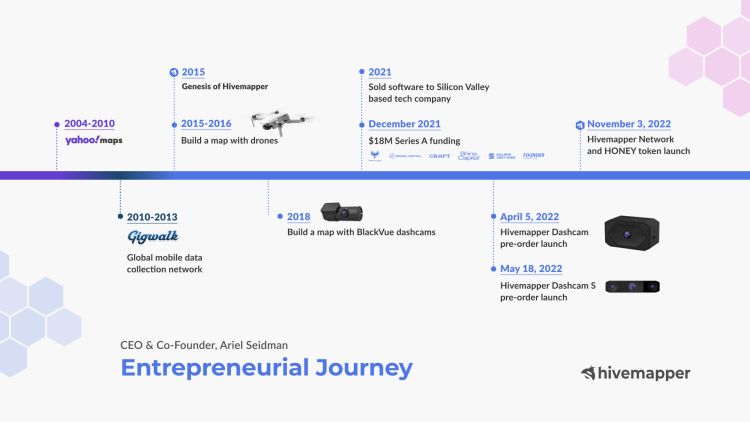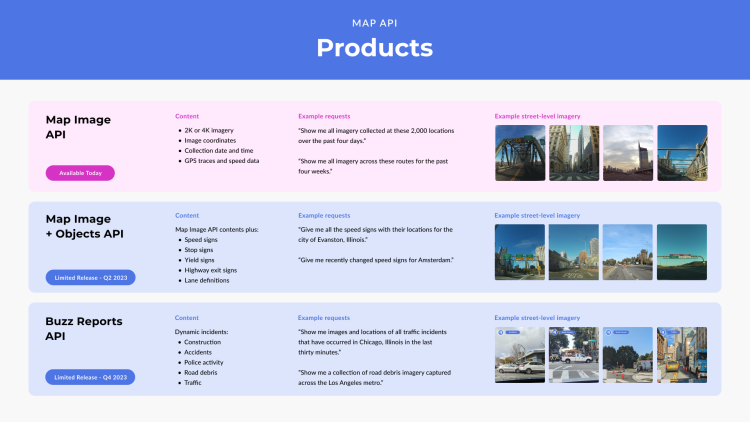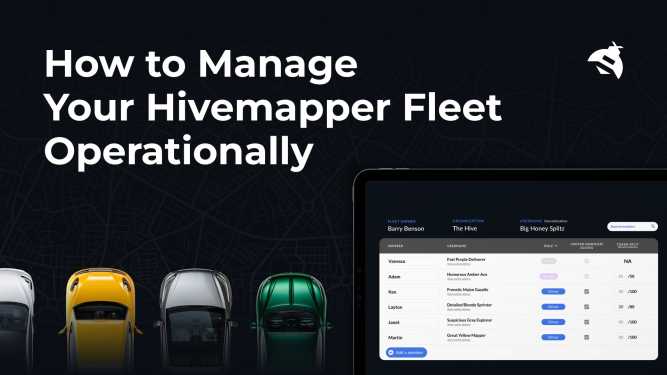The Latest Buzz
The Entrepreneur Journey: On a Mission to Build the World’s Freshest Map

Where does your passion for maps come from?
I fell in love with maps back in my early days at Yahoo! Maps. I got very lucky that one of my first jobs out of school was on a product that I happened to fall in love with. Maps are that rare combination of art and utility, they are both incredibly beautiful and useful. Billions of people rely on maps every day of their lives.
As is true for most entrepreneur journeys, mine has been a rollercoaster. Through the ups and downs, my mission has always been the same: Build the world’s best map. I started out on this mission almost two decades ago at Yahoo! Maps. Back then, Yahoo! Maps was competitive with Google Maps. After years of competing, it became clear that we were losing the battle. Losing is not fun, and I wanted to figure out how to build a truly world class global map.
In 2010, I started my first company Gigwalk, a global data collection network using iPhone and Android devices. Three years in, we hit a couple challenges. First, the collection experience was active rather than passive, which undermined the economic viability of the network as people had understandably high expectations. Second, we didn't own the data, the customer owned the data and so the unit economics were atrocious.
Getting back to my mapping roots, I saw an opportunity to build a map with drones in 2015. Yet, that did not scale. We were not able to overcome the limitations of battery life and government regulations. So, we pivoted to collecting street-level imagery with third party dashcams. It was clear that this was a better approach, but it also had some limitations that we had to solve. This served as a proof-of-concept and launching pad for the blockchain-based and crypto-incentivized decentralized mapping network that the Hivemapper Network is today.
What is Hivemapper’s mission?
At Hivemapper, it’s always been about mapping. Our core team has a background in mapping. We’re a team of builders who are focused on utility and actually building something for the real world and for real people. Our mission is to build the world’s freshest decentralized map with transparent and aligned incentives at a fraction of the cost.
I believe the crypto winter has been good for the survival of the fittest. It has weeded out valueless projects and let meaningful projects like Hivemapper and Helium sprout and thrive. In just four months, Hivemapper has become the second largest DePIN (decentralized physical infrastructure) network, second to Helium.
How’s Hivemapper doing since its launch?
After years of designing and building our software and hardware, we launched the Hivemapper Network on November 3, 2022. It’s been amazing to watch the Hivemapper map grow exponentially over the past couple months.
While the rapid growth might come as a surprise to an outsider, this is not an overnight success story. It’s a culmination of long hours over many years building different versions of this product. We persevered through the ups-and-downs and gained the first-hand experience necessary to create a user-friendly product that has tremendous value in the real world. And we’re just getting started.
We recognize that there’s lots of room for improvement in our product and are committed to making the end-to-end experience for contributing to the global map better each week.
For the most up to date stats, take a look at the Hivemapper Dune Dashboard.
In a nutshell, what is the Hivemapper Network?
The Hivemapper Network is a user-driven and governed decentralized global mapping network that sources street-level imagery and map data and continuously refreshes it. It’s built on the Solana blockchain, has a native crypto token, the HONEY token, and its own street-level imagery and map data collection device, the Hivemapper Dashcam.
The Hivemapper Network is a two-sided marketplace of map contributors (supply) and consumers (demand). Map contributors are drivers and QA reviewers. Map consumers are automakers, rideshare companies, government organizations, and others.
While Hivemapper will offer consumer navigation capabilities to active map contributors with a dashcam, it’s currently focused on monetizing the map by building mapping data products.
Why is there a need for Hivemapper on the supply side?
The supply side collects and edits map data. Companies like Google Maps and Waze take consumer data for free. When you agree to their terms of service, you effectively agree to let them use and monetize all of your sensitive location data.
At Hivemapper, we believe that people should be rewarded for their contributions. We put a lot of thought into designing a tokenomics system that fulfills two goals: 1. Reward contributors fairly. 2. Incentivize map coverage and freshness where there is the greatest demand. Without our contributors, there is no map.
It's been amazing to watch 10,000+ contributors grow the Hivemapper decentralized global map exponentially. Our 20,000+ community members on Twitter and Discord have been pushing the envelope of what's possible with this powerful crypto miner for mapping.
Our missions to crowdsource the world’s freshest map would not be possible without our contributors. All the people participating in the Hivemapper Network have demonstrated a passion for mapping, technology, and decentralization--and have amazed onlookers with their ingenuity and creativity.
Additional reading:
Why is there a need for Hiveampper on the demand side?
As a monopoly, Google Maps can increase prices because they are the dominant provider in this space. Google Maps API prices have increased by 1,800% over the past few years.
Even if you decide to never use the Google Maps app, you are still using Google Maps as you go about your day because Google Maps APIs are integrated into millions of products like Uber, Yelp, insurance companies, government organizations, and many others. These companies and organizations buy Google Maps APIs, and they pay a lot for that. There are about four to five million businesses that use Google Maps APIs and pay a significant amount of money.
The centralized Google approach of building a map is incredibly expensive. Each Google StreetView car costs half a million dollars. They have their own airplanes and thousands of map editors reviewing the data. And it’s not like you just do this once and then you are done. Google Maps has to continuously be running their mapping and data collection operations to maintain the map. That gets expensive real fast.
Therefore, even a company like Google is limited in terms of coverage–and most importantly freshness. There is a huge drop off in map quality, coverage, and freshness beyond the United States and a few EU countries.
Let’s talk about coverage. Places like Lagos, Nigeria, which is over 16 million people, Manila, Philippines, which is over 1.8 million people, and many parts of South America and Southeast Asia simply do not have a map that is anywhere nearly as good as the map that you and I use in San Francisco and other US cities.
Now, let’s talk about freshness. In many parts of the world, a Google StreetView car only sees a location every 1 to 5 years. Even places like San Francisco or Los Angeles are refreshed only after many months or even years. Hivemapper on the other hand can see a location 24-100 times more frequently than Google because it’s decentralized across so many more vehicles. And the cost of actually collecting that data is dramatically lower.
How has the definition of a fresh map evolved?
The definition of a fresh map is changing. It used to be that a fresh map was defined in years, every year or so the map publisher would introduce a new version of the map like a college textbook. Maps refresh more frequently than they used to but they are still much too slow to update. Use cases like ADAS (advanced driver assistance) and AR require maps that are incredibly fresh because they help the vehicle understand its surroundings (lanes, speed limits, etc.) and operate safely in poor weather conditions and low-light conditions. If you are walking around with AR glasses and they are animating a virtual object (say a lizard) onto a physical object like a bus stop or fire hydrant, and that physical object is no longer present then the effect of the AR is lost.
How will Hivemapper disrupt a monopolized industry?
So let's use Waze as one example. In my view, Waze was the last significant potential competitor to Google Maps. Google Maps realized that and acquired them, and effectively just put that thing on ice. And it's just dying a slow death and they don't care. Waze was really onto something and part of me wishes that they had never sold to Google because it dramatically killed Waze’s rapid innovation and hurt the competitive nature of maps.
I think this is where crypto plays a very important role. All of those contributors that helped build Waze, ultimately when Google acquired them for something like $1.3 billion, they saw nothing. And a lot of people feel really burned by that.
With crypto, sharing rewards among the community based on the value of the contributions made ensures that everybody is economically aligned. This discourages short-term thinking and means that contributors really care about the map and want it to succeed. They care about map quality, they care about map coverage.
Why is the Hivemapper Dashcam expensive?
I fully appreciate that the cost of the current Hivemapper Dashcam is on the more expensive side. We not only built a high quality dashcam, but also a high quality mapping sensor which certainly drove up the cost of these two initial models. There is already an existing market for dashcams and we wanted to ensure that we can build a dashcam that solves an existing problem for Uber, Lyft, etc. drivers, while also ensuring that the dashcam was collecting high quality imagery and location data.
We have demonstrated that we can build and ship a dashcam, and we will work with hardware partners to build additional dashcams at different price points so we can expand access.
Additional reading:
What’s on the roadmap for Hivemapper in 2023?
Fleets — We recently launched Fleets, which gives fleet operators a set of tools for onboarding their drivers and managing them. A fleet operator could be a local garbage truck provider with 100 trucks or it could be a limo service with 10 vehicles. Professional drivers rack up plenty of miles and often see parts of the city that your average driver never sees. We are going to make the Fleet tools far easier and more powerful.
Buzz Reports — these reports are like Waze reports of accidents, road debris, construction but with real and fresh imagery of the issue so you can understand exactly what is happening. Is this a three car crash causing the backup or a small fender bender.
Map API Data Products — with map coverage growing exponentially we are now starting to invest in the map data products that businesses consume. You can learn more about that here.
Hivemapper App — not only will we continue to make the App to Hivemapper Dashcam collection experience easier and more passive but we will add navigational capabilities.
Share Post





